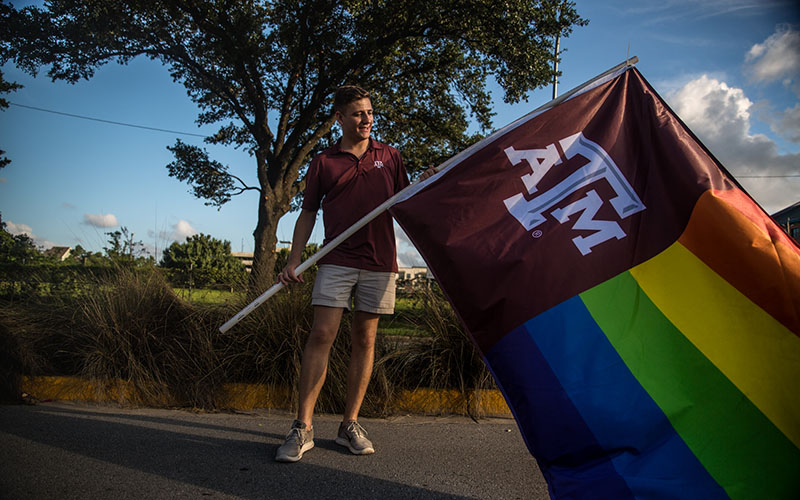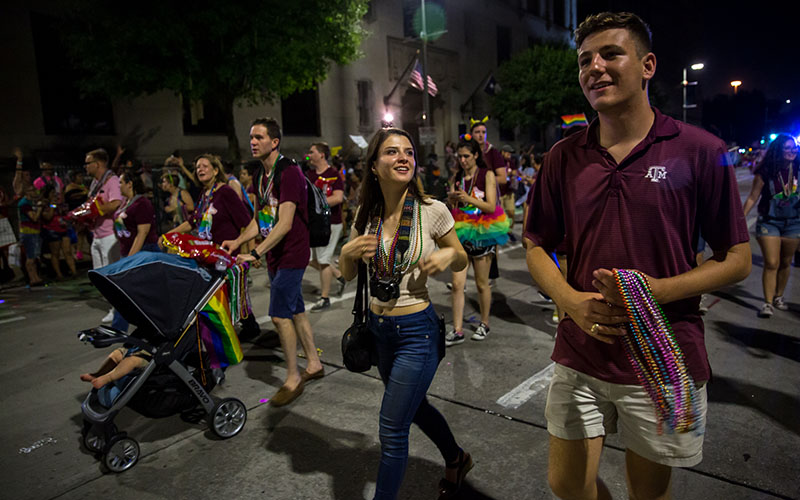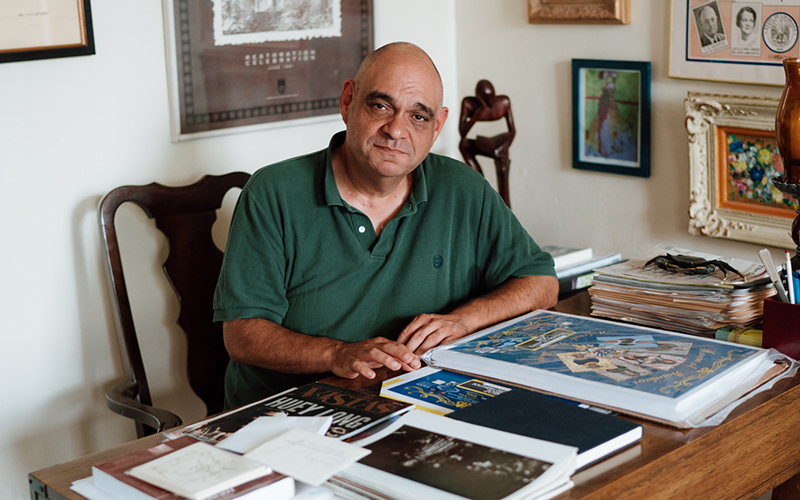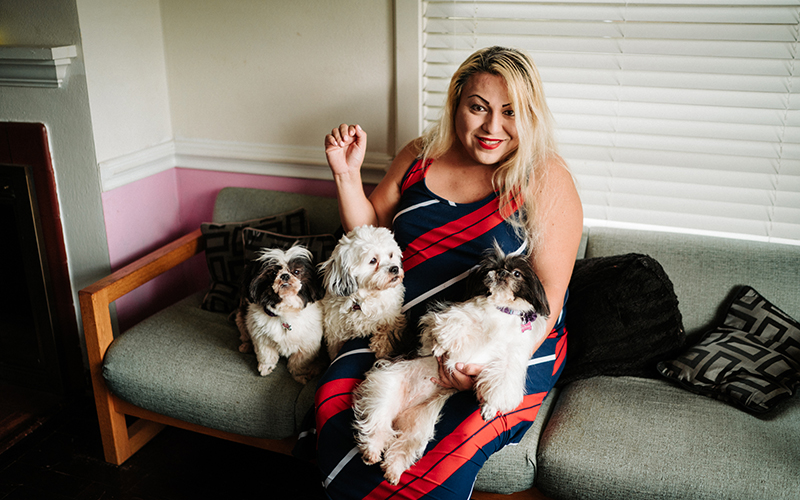
Austin Muckelroy celebrates at Houston Pride Parade in June. (Photo by Shelby Knowles/News21)
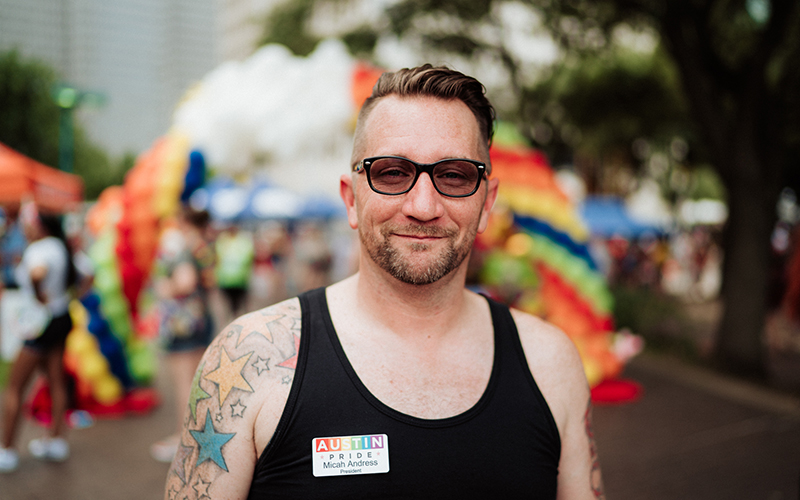
Michah Andress, president of Austin Pride, attends the 2018 Houston Pride Festival in June. He said such events are important in the continued effort for equal treatment for the LGBTQ community. (Photo by Megan Ross/News21)
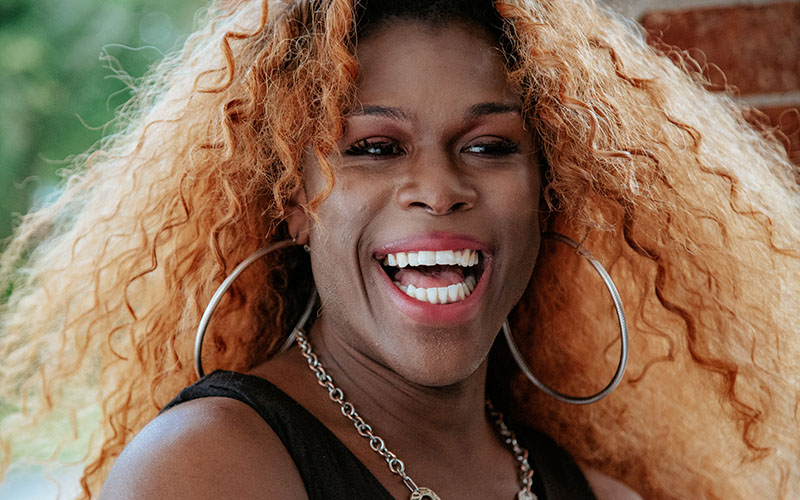
Lauryn Garrett is an African-American transgender woman in Jacksonville, Florida, who is currently in the middle of her fourth attempt at fully transitioning. “I don’t like to say being black and trans is this huge thing, but it is,” Garrett said. “To me, it means I have to work harder at being who I am.” (Photo by Daniel Smitherman/News21)
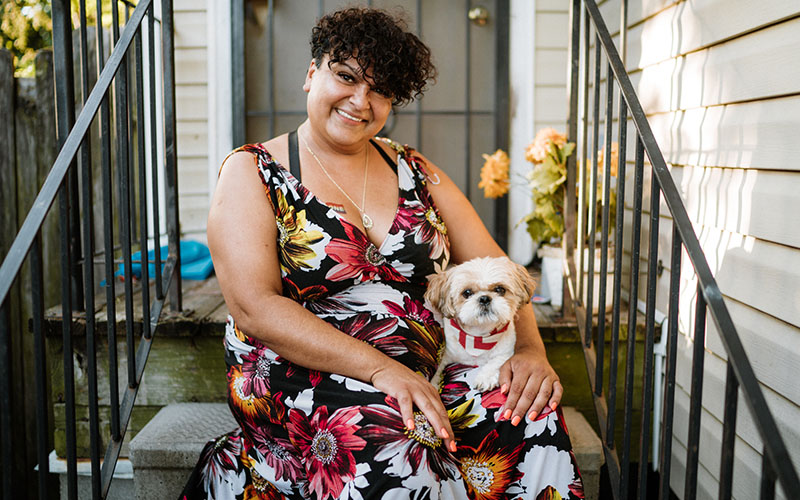
Jada Mercedes Cardona is a transgender Latina woman from New Orleans who said she was assaulted and harassed daily while riding public transportation during her transition. She said passengers would throw bottles, call her a faggot and assault her at bus stops. “I isolated myself in my house for a year,” Cardona said. “I was so afraid to step out of my door. If you are not passable, you get harangued every day. You have to have nerves of steel to actually come out as trans. In your truth, there is violence.” (Photo by Megan Ross/News21)
SAN FRANCISCO – Violent crimes and other hate incidents against lesbian, gay, bisexual and transgender Americans are consistently not reported and prosecuted because of chronic distrust between the LGBTQ community and police.
Nearly 300,000 crimes may have been committed against people across the United States because of their sexual orientation from 2012 to 2016, according to a News21 analysis of data from the federal National Crime Victimization Survey, which tens of thousands of American households fill out each year.
“There are people that are hurting right now who don’t trust the police and also don’t feel comfortable coming forward or speaking up,” said Sheryl Evans Davis, executive director of the San Francisco Human Rights Commission. “Until we have an increase of people reporting things, then we could be doing (more). We’re still not really doing enough for them.”
News21
This report is part of the “Hate in America” project produced by the Carnegie-Knight News21 initiative, a national investigative reporting project by top college journalism students and recent graduates from across the country and headquartered at the Walter Cronkite School of Journalism and Mass Communication at Arizona State University.
U.S. Department of Justice documents for the relatively few federally prosecuted hate crime cases since 2009 tell stories of beatings, robberies, slurs, profanities and fatalities targeting LGBTQ individuals.
Steven Nelson, a 49-year-old gay man, died in an Idaho hospital hours after being lured into the woods by an online ad for a sexual encounter in April 2016. His attacker, Kelly Schneider, repeatedly kicked him with steel-toed boots while yelling homophobic slurs, then stripped and robbed him.
David Beltier and his boyfriend, Jeremy Mark, were walking their pink-dyed poodle, Beauty, in Hillsboro, Oregon, when George Mason got out of his car and beat Beltier with a metal tool while yelling gay slurs in March 2013.
Three gay men were walking through a Seattle neighborhood in January 2015 when Troy Deacon Burns began to tail them, shouting homophobic slurs and eventually threatening them with a knife and attempting to stab one of them.
Experts and such advocates as Seth Brysk, the central Pacific regional director of the Anti-Defamation League, believe many similar crimes are not reported to law enforcement, much less recorded by the FBI or prosecuted. Only 1,776 of the 15,254 police departments participating in the FBI’s crime tracking program reported hate crimes in their jurisdiction in 2016, at a time when other measures indicate a sharp rise in bias-motivated crimes.
“We know that the reporting of hate crimes is vastly underreported,” Brysk said. “So it’s important for law enforcement to do everything possible in their power to make it … easy as possible for people to feel comfortable and willing to go and report these crimes. And that they then are faithful to their own position and reporting up the chain.”
From 2012 to 2016, about 20 percent of hate incidents reported to the FBI’s Uniform Crime Reporting program were sexual-orientation bias crimes. Although sexual orientation isn’t limited to lesbians, gays and bisexual people, sexual minorities comprised the majority of the victims.

Attendees gather for the Houston Pride Parade in June. Excluding marriage equality, there are few federal protections for LGBTQ people. There is no federal law barring discrimination based on sexual orientation and gender identity in housing, public or private employment, or public accommodations. (Photo by Shelby Knowles/News21)
“The numbers look big, but I think they’re even bigger if you really did have everybody who has experienced any hate crimes come forward when they should,” said Angelic Setchell, the anti-violence program specialist with the Montrose Center in Houston, a LGBTQ social services organization.
Setchell said she encourages hate crime victims she works with in Houston to report their experiences to the police, but some are reluctant because they haven’t revealed their sexual orientation to family or employers. Others fear being targeted again if they go after their attackers in court.
The more frequently someone is subjected to bias-motivated hostility, the less likely he or she may be to report the behavior to the authorities, said Gregory Herek, an anti-LGBTQ hate crime expert who retired from University of California, Davis.
“If a person has insults yelled at them several times a day, the idea that you’re going to try to deal with each of those by going to the police or by reporting something is just not worth it for the individual,” he said.
Sneh Rao, director of policy for the Policy and Social Justice Division for the San Francisco Human Rights Commission, said anti-LGBTQ hate-crime numbers would look much larger if the LGBTQ community was more trusting of law enforcement.
“What success might actually look like is a spike in the reported numbers of hate crimes, and that would tell me that people are actually starting to trust our police,” Rao said.
When Bobby Brooks was elected Texas A&M University’s first openly gay student body president in March 2017, he was targeted with threats of bodily harm and homophobic slurs and tried to report it to the local police.
The threats on Facebook and Twitter came after then-Texas Gov. Rick Perry wrote an editorial in the Houston Chronicle questioning Brooks’ election. Initially, Perry said, he considered Brooks’ election “a testament to the Aggie character.” But after discovering Brooks’ opponent had been disqualified for failing to disclose campaign expenses, Perry questioned whether A&M’s ‘quest for “diversity” ‘ was behind the election.
“Rick Perry’s letter was the single greatest catalyst for me receiving death threats,” Brooks told News21. “(Perry) gave a lot of permission to allow hateful speech. He was able to write this letter and wash his hands of it because he’s Rick Perry.”
Three weeks after results became official, Brooks was at a convenience store in Longview, Texas, when he noticed glares and whispers from a group of people he recognized as Texas A&M students. He left the store and his traveling companion soon followed him, crying. She told him after he walked out, the students used homophobic slurs and recorded him in Snapchat videos while saying, “I’m going to (expletive) you up.”
Brooks turned to a university adviser, who encouraged him to report the incident. When he contacted the Longview police he said the responding officer told him, “Well that doesn’t sound like a problem to me. It sounds like those are just some words.”
“The police wouldn’t even take a report, wouldn’t even take it seriously,” Brooks said. “They laughed me off the phone. … Nobody let me do anything about it, and it’s so frustrating when there’s a system designed that won’t recognize your struggles and then people will only base their understanding of discrimination based off of what that system perceives as discrimination.”
Herek from UC Davis said the responding officer and the quality of his or her LGBTQ cultural-competency training can have a direct effect on whether a bias crime is properly recorded. The officer must know which questions to ask the victim, understand how to identify a potential hate crime and take the additional steps to classify the incident in the department’s system, he said. Then, the department must share this information with the FBI to facilitate accurate tracking.
“There are all these things that can go wrong,” Herek said.
An investigation by ProPublica’s Documenting Hate project showed, for example, that a number of local police reports of hate crimes to the FBI mistakenly labeled homosexual victims as heterosexual by marking the wrong box.
Communication problems also can hinder law enforcement in properly recording or pursuing a hate incident.
As Daniela Marroquin, 40, a transgender Latina woman, walked home from her regular breakfast spot in Jackson Heights, New York, in August 2016, a man approached and berated her with anti-immigrant and homophobic slurs and profanities. Marroquin tried to avoid confrontation but the man kicked and struck her, knocking her down.
Marroquin said she called the police as soon as she got home, and responding officers quickly apprehended her attacker. But the officer who took Marroquin’s initial statement spoke little Spanish and didn’t record the slurs or verbal assault that occurred during her attack, she said.
When she later tried to correct the statement, she was told she was changing her story.
“The officer’s assistant told me that what I was saying changed everything because what they had written wasn’t what I was saying. And I told (them), “He insulted me… each time he struck me, he would yell that I was a faggot, a shitty faggot,” Marroquin said in Spanish. “And there was nothing about the insults – nothing about what truly happened was (in the report). They only said he assaulted me.”
Marroquin’s case wasn’t investigated as a hate crime. She saw her attacker walking free two weeks later.

Marchers stream toward downtown Houston during Houston Pride Parade in June. Nearly 300,000 crimes may have been committed against people across the United States because of their sexual orientation from 2012 to 2016, according to a News21 analysis of data from the federal National Crime Victimization Survey. (Photo by Shelby Knowles/News21)
Police officers’ attitudes also influence the willingness of future victims to come forward, said Elaine Maccio, an associate professor of social work at Louisiana State University who specializes in LGBTQ issues.
“If an LGBTQ person who suspects he or she has been discriminated against based on sexual orientation or gender identity or expression comes forward with that, if it doesn’t go well, then the message to the rest of the LGBTQ community is, ‘Don’t bother. You better not try this again, because look what’s going to happen,’ ” Maccio said.
In a 2012 national survey, Lambda Legal, the nation’s oldest and largest LGBTQ nonprofit legal organization, found 14 percent of its 2,376 respondents had been verbally assaulted by a police officer in the previous five years. Two percent reported experiencing physical assault, and 3 percent sexual harassment, at the hands of officers.
The online survey was conducted in Spanish and English for five months. The survey was disseminated to approximately 50 Lambda Legal affiliates nationwide and promoted via email and social media.
The National Center for Transgender Equality, a transgender advocacy organization founded in 2003, documented a trend of law enforcement distrust in its 2015 U.S. Transgender Survey. The survey was available online over a 34-day period in 2015 across all 50 states, the District of Columbia and multiple military bases and territories.
Just more than half the 27,715 respondents said they would feel uncomfortable calling the police for assistance, and 58 percent said they were mistreated, either verbally, physically or sexually, by police in 2014 and 2015.
Clair Farley, San Francisco’s senior mayoral adviser for transgender initiatives, said even in San Francisco, where the police department has an LGBT Community Advisory Forum, transgender residents and others in the LGBTQ community often don’t trust law enforcement.
“There’s been a lot of work with the new recruits around LGBTQ trainings and trans work,” Farley said. “But for oldtimers and people who have been on the force for a long time, it’s harder to change.”
Herek from UC Davis said such clashes as the Stonewall Riots, a 1969 protest sparked by a New York City police raid on a Greenwich Village gay club, and lesser-known conflicts have left feelings of “residual distrust” in older LGBTQ individuals. For years, homosexual activity was illegal and LGBTQ people concealed their orientation to avoid criminalization and persecution, Herek said.
A 2003 U.S. Supreme Court ruling in a Texas case invalidated state anti-sodomy laws as unconstitutional, but many LGBTQ people may still believe “it’s safer not to let it be known they are who they are” when engaging with police officers, Herek said.
In 2012, the Justice Department ordered the New Orleans Police Department to reform a department riddled with biased policing and “a lack of respect for the civil rights and dignity of the people of New Orleans.” The Justice Department report said community members “believe some officers equate being African-American and transgendered with being a prostitute.”
The department agreed to reform its policies, including refraining from aggressive frisk procedures – which had involved patting down transgender suspects’ genitals to confirm their sex – and adopting gender-affirming language, such as addressing people by their chosen name, title and pronoun. Misgendering, or referring to a transgender person using a name or gender pronoun with which they do not self-identify, is a common complaint made by transgender individuals against law enforcement nationwide.
Other police departments, including the Newark Police Department in Newark, New Jersey, and the Baltimore Police Department, agreed to consent decrees with the Justice Department in recent years to improve treatment of LGBTQ people. Other cities have worked on their own to repair distrust by creating liaison positions between their police departments and LGBTQ communities.
James Flavin, the LGBTQ liaison and assistant chief for the San Antonio Police Department, said he conducts sensitivity trainings for officers, involves himself in individual cases and works with local advocacy groups to strengthen trust.
Liaisons are important both symbolically and practically, said Christy Mallory, director of state policy and education initiatives with the Williams Institute on Sexual Orientation and Gender Identity Law and Public Policy at UCLA. A Williams Institute study found adding an LGBTQ liaison to a police department has been tied to an increase in the reporting of anti-LGBTQ hate crimes to that department.
“(A liaison) is important in sending the message that there’s someone people can go to,” Mallory said. “If they can look online and see that person and a profile about them, they may feel safer approaching them about what’s happened to them and being honest about being LGBTQ or being targeted because they were LGBTQ.”
Even if police accurately record the specifics of an attack, other circumstances may stand between a victim and legal justice.
Brandon Ballone, 27, a white gay drag performer, was a victim of violent crime during a night out in the Hell’s Kitchen section of New York City in April 2016. Ballone was wearing a T-shirt advertising his drag-queen personality when a group of teenagers beat him with a glass bottle, leaving Ballone with a severed tendon in one hand, a torn ear and damaged jaw.
“Emotionally, to get better it took me probably over a year,” he said. “Still there’s days where I have a little PTSD. I rarely walk home late at night on the streets.”
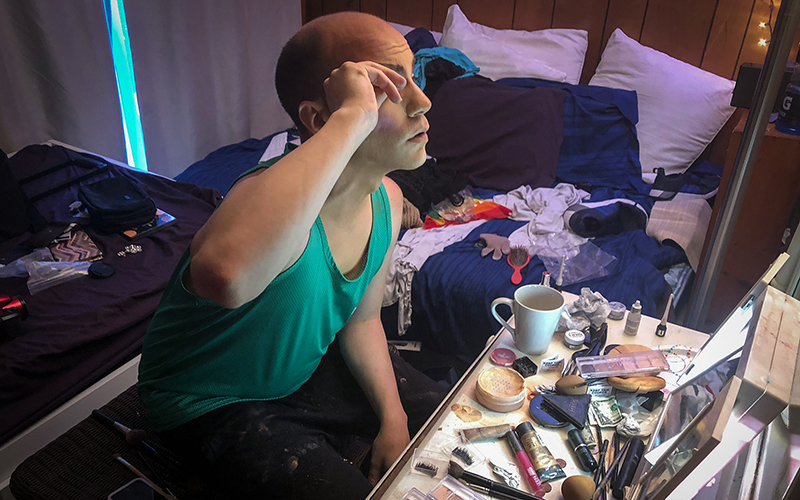
Brandon Ballone, a drag queen in New York, prepares for a show at his home near Long Island. He was a victim of violent crime during a night out in April 2016. “Emotionally, to get better it took me probably over a year,” he said. “Still there’s days where I have a little PTSD. I rarely walk home late at night on the streets.” (Photo by Emmanuel Morgan/News21)
Ballone can’t remember whether his assailants used homophobic slurs or called him names during the attack; he was in shock and focused on protecting his friend and getting to safety. As a result, police didn’t investigate the attack as a hate crime.
“I had told them, ‘In my opinion, anybody who attacks someone in that kind of way, it seems to me that there is a lot of hate there,'” Ballone said. “But apparently, a hate crime, to them, to label it a gay bashing, I would have had to hear them say the word ‘faggot,’ and that was kind of the response I was given.”
The burden of proof required to substantiate a hate-crime claim makes pursuing bias charges difficult, leaving victims like Ballone without full legal recognition. Verbal or written anti-LGBTQ slurs are most often used to identify anti-LGBTQ animus during potential hate crimes, and if the assailant does not speak or the victim doesn’t clearly hear hate speech, intent can be difficult to prove.
Regardless of evidence, if a state doesn’t have an LGBTQ-inclusive hate-crime law, the probability of prosecution decreases.
Fourteen states have hate-crime laws that do not include sexual orientation or gender identity, and hate-crime laws in 20 states cover only sexual orientation. Arkansas, Georgia, Indiana, South Carolina and Wyoming have no such laws. When state law enforcement does not or cannot pursue charges for these crimes, jurisdiction falls to the federal government.
In 2009, President Barack Obama signed the Matthew Shepard and James Byrd Jr. Hate Crimes Prevention Act, which expanded the federal hate-crime definition to include crimes motivated by the victim’s real or perceived sexual orientation and gender identity.
News21 found that only 12 cases involving LGBTQ victims have been prosecuted on a federal level, with 18 defendants sentenced under the Shepard-Byrd Act.
Only one of the federally prosecuted cases involved a transgender individual, although hate crimes against transgender or gender non-conforming persons have increased from 31 to 124 incidents reported to the FBI by local police from 2013 to 2016.
In the one federal transgender case, Mercedes Williamson, a 17-year-old transgender woman, was murdered in May 2015 by her ex-boyfriend, Joshua Brandon Vallum, who feared retribution if his fellow gang members discovered he had a consensual sexual relationship with a transgender woman. Vallum tased Williamson, stabbed her in the head and body multiple times as she fled and delivered fatal blows with a hammer after she stumbled into the woods.
Vallum was sentenced to 49 years in federal prison for assault and murder. But before he pleaded guilty, Vallum “falsely claimed to law enforcement that he killed Williamson in a panic after discovering Williamson was transgender,” according to reports from the Justice Department.
Vallum’s argument, known as the “trans panic” or “gay panic” defense, has been used by perpetrators who claimed they reacted violently after being alarmed by what they perceived as advances from a gay or transgender person.
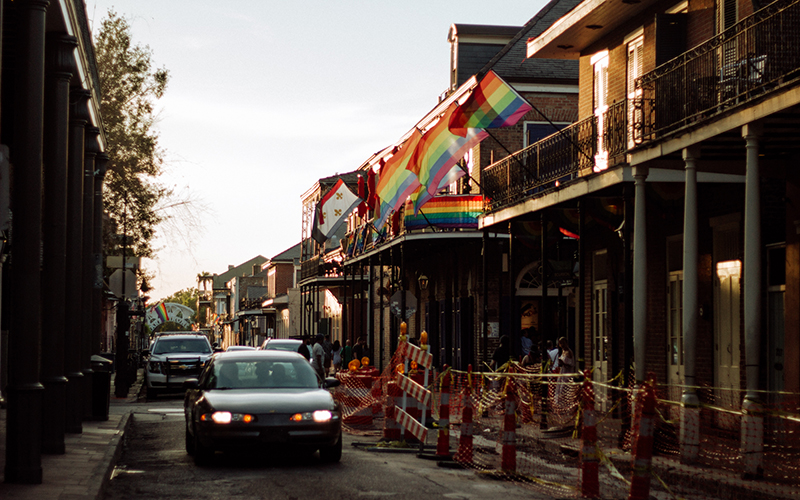
Multicolored LGBTQ flags fly from a balcony in the New Orleans French Quarter. In 2012, the Justice Department ordered the New Orleans Police Department to reform a department riddled with biased policing and “a lack of respect for the civil rights and dignity of the people of New Orleans.” The department agreed to treat transgender individuals, in particular, with more respect. (Photo by Megan Ross/News21)
In July, U.S. Sen. Edward Markey and U.S. Rep. Joe Kennedy, both Democrats from Massachusetts, introduced the Gay and Trans Panic Defense Prohibition Act of 2018 to ban the use of either defense in federal court. California, Illinois and Rhode Island already prohibit gay and trans panic defenses.
Excluding marriage equality, there are few other federal protections for LGBTQ people. There is no federal law barring discrimination based on sexual orientation and gender identity in housing, public or private employment, or public accommodations.
“(Things) are not perfect, they’re not perfect at all. They’re barely even good,” said Micah Andress, president of Austin Pride in Texas. “Yes, we have marriage equality, but what else do we have?”
Statutes prohibiting discrimination based on sexual orientation or gender identity vary depending on state, county and city. Only 19 states and the District of Columbia fully prohibit discrimination based on sexual orientation and gender identity, while New York and Wisconsin have explicit legislative coverage for sexual orientation alone, according to LGBTQ advocacy group Freedom for All Americans.
Herek from UC Davis said if societal norms dictate that discriminatory behavior is acceptable, escalating acts of hate or violence also may be seen as admissible.
“If it’s OK to be verbally hostile,” Herek added, “to say nasty things to a person about their sexual orientation, that creates a general sense that it’s probably OK to do other things against them as well.”
News21 reporters Abby Bitterman, Penelope Blackwell, Renata Cló, Shelby Knowles, Lenny Martinez Dominguez, Emmanuel Morgan, Justin Parham and Jasmine Putney contributed to this article.
This story was reported in partnership with ProPublica’s Documenting Hate Project, which is collecting reports about hate crimes and bias incidents. If you’ve been a victim or a witness, tell us your story here.
Connect with us on Facebook.
